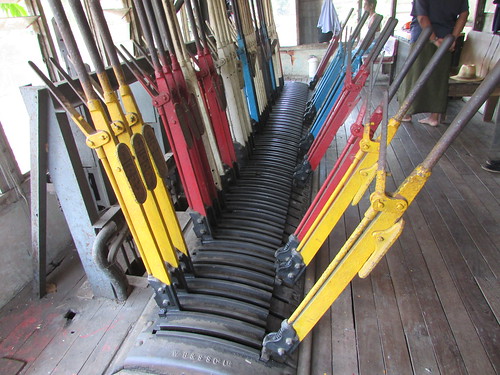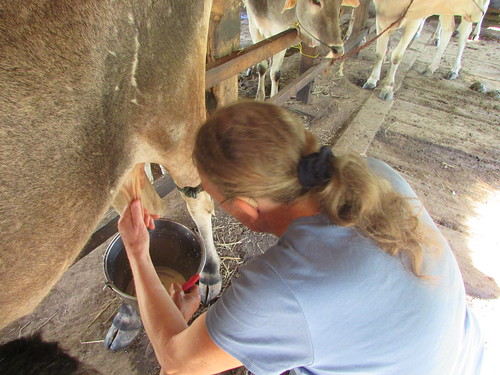skip to main |
skip to sidebar
Events of Friday, 6th May 2016
One advantage of the Park Royal is that it's only about ten minutes walk from Yangon Central Railway Station. I'd hoped it might be possible to go on the suburban line towards Thilawa but the hotel didn't think that would be possible because of the sparse service, which I suspected might be the case, so instead I decided to take the Circle Line clockwise as far as Kyee Myin Daing (which was the terminus of the first railway in Burma) and do some railway exploring. Then, if not too tired, I would proceed further clockwise to Insein for more exploring before returning to Yangon by an anti-clockwise Circle Line train.
I left the hotel at about 8.00 a.m. and made the trips and explorations as planned. With my interest in railway signalling, the high point of an enjoyable (but hot) morning was managing to get invited into Kyee Myin Daing South Signal Cabin, with its elderly Westinghouse mechanical lever frame. There's a post about my visit to Kyee Myin Daing here.
 Mechanical lever frame at Kyee Myin Daing South Signal Cabin.
Mechanical lever frame at Kyee Myin Daing South Signal Cabin.
It wasn't just about railways - travelling on the train in Myanmar is an splendid was of 'people watching' and learning a little about the lives of Myanmar people.
It was around 1.00 p.m. when I returned to the hotel and, in view of the long journey back to England which would start early the following day, I decided to stay in the hotel for the rest of Friday, using the internet.
Related posts
This is currently the last post describing this trip.
All my posts on this trip can be found here.
My pictures
Yangon to Insein by Train (mainly railway technical pictures but with some 'general' shots).
Kyee Myin Daing South Signal Cabin.
There are also pictures of this trip here.
More pictures will be posted as soon as possible.
[Link to pictures 'Yangon to Insein by Train' added 7-May-2016]
Events of Thursday, 5th May 2016
Kalaw Hill Lodge offer various 'Activities' around their extensive site and I went on the Nature Walk starting at 7.30 a.m. It was just me and a pleasant young lady from their 'Operations Department'. We walked down steps, went through their organic garden to the lowest point of their estate, with an attractive brown stream running through. We came to a small field where a buffalo and its handler were demonstrating harrowing. We then climbed the hill at the rear of the site where there was a 'tame village' of two or three typical houses where the occupants live in traditional ways. I normally disapprove of this sort of slightly 'synthetic' experience but it was well done and I enjoyed the activity.
In the cowshed, the farmer demonstrated hand milking a cow but, despite carefully observing the farmer's technique my own attempt at milking was an abject failure.
 Jan's attempt at milking was an abject failure.
Jan's attempt at milking was an abject failure.
We were then offered a cup of 'Organic Milk', served hot presumably to pasteurise it. Then it was a gentle walk back to the main building where my breakfast was promptly served. Finally, I enjoyed a 15-minute ride in a traditional ox cart, looping out of the lodge grounds and back in again.
 The ox cart ride.
The ox cart ride.
By the time I'd finished my packing, it was 10 o'clock and Sai Kyaw Kyaw had arrived with the car to show me around Kalaw before taking me to Heho airport for an afternoon flight back to Yangon, where I was booked into the Park Royal Hotel for my last two nights in Myanmar.
Related posts
Next post describing this trip.
All my posts on this trip can be found here.
My pictures
Activities at Kalaw Hill Lodge.
There are also pictures of this trip here.
More pictures will be posted as soon as possible.
Thazi is an important station on the Yangon to Mandalay main line which is now mainly (if not completely) double track with left-hand running. With few constraints on space when built, the track layout is spacious and five through platforms, plus a bay facing south, are provided. The main station building is on the west side, adjacent to platform 1.
Thazi is the junction for the steeply-grade branch to Kalaw and Yaksauk which includes two zig-zag sections so it was logical to provide motive power for this branch from a locomotive depot at Thazi. Originally, of course, this was a steam shed and home to some of Burma Railways massive Beyer Garratts. What is now a Diesel Locomotive Depot is just north of the station on the west side. I found one of the Beyer Garratts (running number GC833, Beyer Peacock works number 7128 of 1943) set aside at Thazi, externally complete cosmetically and repainted (16.07.2006) but with quite a lot missing. There was also an outside cylinder six-coupled side tank, carrying running number S.1, plinthed on the approach to the depot.
I wasn’t able to check the diesel shed itself but I could see at least four Bo-Bo-Bo diesel electric locomotives (including DF.2013) variously built in either France or China plus an unidentified light railcar. Near the station. I passed Railway Gang Cars ED/RGC-62 and ED(M) RGC.29.
A relic of steam days was the two massive round water tanks mounted on steel-framed towers, at the south of the station on the west side near a covered shed where carriage maintenance was being carried out. Two out-of-use water columns for steam locomotives survive.
Overhead water supplies are found at many stations on Myanma Railways for replenishing lavatory tanks of passenger coaches. At Thazi, these were provided on a number of platforms but delivery nozzles were only fitted on platform 1.
Another commonly-found feature was the fence between platform 1 line and platform 2 line, to prevent too indiscrimate crossing of the lines by passengers. Crossing the line is still the norm and, as usual, the fence was provided with an opening opposite the entrance from the main station building which most passengers choose to use, although Thazi also has a substantial steel footbridge linking the three platform groups [1], [2, 3 and Bay], [4,5]. No fencing was provided across the other tracks so people, dogs and goats were free to cross the lines anywhere. My railway training forced me to look both ways before crossing any line, but I’ve seen scant evidence that local people give any thought to the possibility of moving trains when crossing railway lines.
Just to the north of the elderly footbridge, there was a more modern reinforced concrete bridge structure, carrying a group of buildings topped by what was presumably the signal box with outward-leaning windows like the control tower of an airfield.
The signalling at Thazi is all-electric, with two aspect running signals and, in most cases, a subsidiary aspect of two diagonal white lights is provided. Where ground level shunting signals are provided, these have three lights providing two aspects. I didn’t identify the point machines but, in places, tubular point rodding allows one machine to operate two switches. At strategic locations, small Location Cases are provided for equipment. Track bonding, as you would expect, suggests continuous track circuiting in the station area. The installation was generally similar to those found in the Mandalay area. I was amused that, in each direction on the main line, fixed distant signals are provided but they are semaphore signals without lighting of the rather crude (and variable) pattern found everywhere in Myanmar.
Immediately south of the station, the main road through Thazi crosses the railway at a conventional level crossing, manned by a Crossing Keeper operating manual gates.
Whilst I was taking pictures, I saw Shunting locomotive DD.510 (built by Kawasaki) shut down just north of the station on platform 5 road, carefully placed in the shade of a large tree between the running lines. After a few minutes, the crew got on, started the engine and shunted light engine, disappearing (I think) to the Locomotive Shed. There's a little more information on this class of 500 h.p. diesel hydraulic locomotives in the post
Diesel Traction in Burma.
To the east of the station there were a number of parallel stabling tracks, accessible from both ends, with a variety of goods rolling stock. Two roads were provided with pits and a roof over part of their length, I imagine for passenger coach examinations but there were only petrol tank wagons there at the time of my visit.
The station building on platform 2-3 was a rather British-looking affair, brick built with a tiled roof. Amongst other offices, there was a Station Supervisors Office and a Radio Room. Beyond the building, substantial steel-framed umbrella roofing was provided.
To be continued ...
Related Posts
You can find all my posts on Myanma Railways here.
My pictures
Thazi Locomotive Depot
Thazi Station
All my pictures of Railways in Burma are here.
 Mechanical lever frame at Kyee Myin Daing South Signal Cabin.
Mechanical lever frame at Kyee Myin Daing South Signal Cabin.


